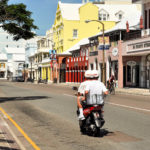French Guiana, officially called simply Guiana, is an overseas department and region of France, on the north Atlantic coast of South America. It borders Brazil to the east and south, and Suriname to the west. Its 83,534 km² area has a very low population density of only 3 inhabitants per km². The total population is only 250,109 . As a territory of France the same laws and rights apply, including gay marriage. But a visitor will find no visible sign of modern gay life in the country thanks to the predominant Roman Catholic faith. Historically, as a penal colony, there are reports of ‘rampant’ homosexuality in the prisons there.
Posted here is a descriptive non-gay story about Guiana—not to be confused with the separate nearby country of Guyana, a former British colony. My research has turned up virtually nothing about LGBT life in Guiana today. In the 20th century Guiana was somewhat reknown, albeit in fiction, when French writer Jean Genet located one of his novels ‘Thieves Journal’ partly in the notorious penal colony in Guiana. There he situated his criminal character in various homosexual acts at the hands of other criminals. Genet was very aware that homosexuality was common in the Guiana prisons and sometimes fantasized being there himself. But in actuality, he never visited Guiana.
Further documentation about the history of homosexuality in Guiana’s jails is found in Stephen A. Toth’s book: ‘Beyond Papillon: The French Overseas Penal Colonies 1854-1952’ which describes the harrowing circumstances of prisons including furtive and overt homosexual activity among prisoners that sometimes led to brutality or death.
(See: https://books.google.com/books?id=opdTr5K0fo8C&pg=PT72&lpg=PT72&dq=homosexuality+french+guiana&source=bl&ots=NXySRsjVJx&sig=YJWvGjTLZ-h3YDnfrB7aZPLXpVA&hl=en&sa=X&ved=0ahUKEwiWqZL23s_JAhVE1GMKHaKtBOo4HhDoAQgoMAI#v=onepage&q=homosexuality%20french%20guiana&f=false)
French Guiana – Out Of This World (a non-gay description of the country)
A corner of South America that is forever France, and where tropical jungle tangles with space exploration.
By Alain de Botton
22 October 2011
Story based on the book by Alain de Botton ‘The Pleasures and Sorrows of Work’ ) http://www.independent.co.uk/travel/americas/french-guiana-out-of-this-world-1670291.html)
The difficulties with French Guiana begin with trying to locate it on a map. Seldom has a place been as easily and as frequently confused with somewhere else: Ghana on the western coast of Africa, Guyana east of Venezuela, Guinea next to Senegal, Equatorial Guinea below Cameroon…
In fact, French Guiana (you can’t call it a country, for reasons that are about to become clear) is located on the malarial northern coast of South America, between Surinam to the north-west and Brazil to the south. The added twist for this impoverished, malarial land is that it is technically part of France.
As with the scattered islands of Guadeloupe, Martinique and Réunion, Guyane – as the French call it – is a Département d’Outre-Mer, having been absorbed by its former colonial master in 1946. As a result, French Guiana is now as much a part of the European Union as Berkshire or Bavaria; its highest legal authority is the Court of Justice in Strasbourg; its agricultural and fishery policies are defined in Brussels; and its currency, valid even in the Indian settlement of Pilakoupoupiaina on the Oyapock River, is the euro, the currency controlled by the European Central Bank in Frankfurt. Indeed, if you look on the back of a euro note, right next to the Greek EYPO, you can see French Guiana in a square of its own.
French Guiana is the size of Portugal. Yet only 200,000 people live here. The country has no economy to speak of. There is hardly any tourism, not least because the sea is plagued by sharks and, inshore at least, is brown from river sediment. Nor, thanks to the poor quality of the soil, is there any agriculture. Roads down to Brazil are largely impassable, and the territory’s sole reliable outlet to the world is the daily flight to Paris Orly from Rochambeau airport in the capital, Cayenne.
A layer of French bureaucracy and bourgeois ambition has been unevenly applied across this tropical kaleidoscope. In tin-roofed villages, terrains de boules abut voodoo temples. The country’s only two main roads, Routes Nationales 1 and 2, are fitted out with standard French signs that point the way to such towns as Iracoubo and Awala-Yalimapo. Restaurants (Café de la Gare, Bar Chez Pierrot . . .) serve escalopes of wild jungle boar and Amazonian river fish with the scaly appearance of prehistoric coelacanths, cut into fillets and domesticated under a meunière sauce.
The French originally came to the region at the end of the 17th-century, in search of rapid bounty. They did away with 10,000 Galibi and Palikur Indians and imported slaves from Africa to harvest sugar and coffee. But the crops failed, and the slaves revolted and hung their masters from the branches of the native Platonia trees.
A century or two passed before a new plan for the territory was hatched, this one involving a penal colony that was intended to emulate Britain’s success at Botany Bay.
But the place refused to become a French equatorial version of Sydney and instead killed off its prisoners by disease faster than the French criminal class could supply replacements. The enterprise nevertheless struggled on for close to 100 years, cementing its international reputation for cruelty and maladministration when France’s most famous victim of judicial error, Alfred Dreyfus, endured four years of solitary confinement in a tower on the not-unfairly named Devil’s Island, 11km offshore.
In the 20th century Guiana was somewhat reknown, albeit in fiction, when Jean Genet located one of his novels ‘Thieves Journal’ partly in the notorious penal colony in Guiana. There he situated his criminal character in various homosexual acts at the hands of other criminals. Genet was very aware that the Guiana colony was rampant with male sex and sometimes fantasized being there himself. But in actuality, he never visited Guiana.
The misery might have continued indefinitely, had it not been for the Algerian War of Independence. This eight-year conflict began in 1954, and obliged France to find a new site for their rocket test base that had only just established at Hammaguir in the Sahara Desert. With its proximity to the equator (important when you are sending things into orbit), its paucity of inhabitants, its political pliancy and its immunity from hurricanes, French Guiana was the obvious location from which to explore outer space.
A high-tech space port was built on a strip of jungle north-west of the capital.
A new town, Kourou, was constructed next door, designed to house workers and their families in functional concrete apartment blocks laid out along wide thoroughfares with grandiose names such as the Avenue de Gaulle and the Esplanade des Étoiles.
This writer travelled to French Guiana on a press trip to witness the launch of a Japanese satellite. The group was billeted together in the Atlantis Hotel which, though only newly built, was fast surrendering itself to tropical mould and the incursions of jungle fauna.
The space town of Kourou was in no better shape than the hotel on its perimeter. Evoking comparison with Chandigarh and Brasilia, two other examples of modern architectural indifference to issues of context and culture, it was in an advanced stage of decomposition after only a few decades of existence.
Beside the man-made lake, unshaded wooden benches rotted unused: they had been deployed to provide respite on the kind of afternoon stroll which it had not yet occurred to anyone in the tropics to take. The concrete façades of buildings had buckled in a climate which from April to July could deliver in a single week as much rainfall as northern France might experience in an entire year…
After the satellite launch (description omitted from this story), I wandered around French Guiana, marveling at its combination of Gallic modernity and South American indolence. No one seemed to do much work; European social security went such a long way here that the fastest way to get rich was to give up one’s job. I ate a number of goat-stew croissants: a local dish perfectly summing up the confused history of the country, but a not-untasty confection.
I ran into a bit of wildlife. One night, while watching TF1 beamed in by satellite from Paris, I was confronted by a muscular and implausibly furry tropical spider the size of the television standing stationary on the wall above the air-conditioning unit. The situation was resolved by a Creole maintenance man who dispatched the monster with a decisive slap of rolled-up newspaper, leaving nothing but a brown sediment to commemorate the presence, then tossed the corpse off the balcony and, with apparent sincerity, bade me a pleasant end to the evening.
I felt keenly the painful psychological adjustments required by life in French Guiana: the need to juggle a respect for the potential offered by science with an awareness of how perplexingly limited and narrowly framed might be its benefits. I felt the temptation of hoping that all activities would acquire the excitement and rigours of engineering while recognising the absurdity of those who, overly impressed by technological achievement, lose sight of how doggedly we will always be pursued by baser forms of error and absurdity.
On my last day in French Guiana, to kill time before my evening flight, I toured Cayenne, ending up in the nation’s main museum. This is a traditional, tin-roofed Creole house in a poor state of repair, filled with pickled snakes and frogs collected by 19th-century naturalists. In a back room hung depictions of the country’s inhabitants at work, across different periods of history.
The first frame was of a family in animal skins peeling fruit; the second of fishermen staring limply from the side of a canoe; the third of a horde of slaves setting fire to a plantation building, and the fourth of a pair of guards standing outside a prison block. Finally, three times the size of the other images, in full and impressive color, came a picture of five white-coated engineers attending to a satellite’s cabling in a hangar in the space centre.
The moral was clear: French Guiana had overcome the degrading labour of its past and was headed towards a future consecrated by the hand of science.Science may not have turned French Guiana into a paradise, but the mixture of 21st-century technology, primitive jungle life and French bureaucracy in the tropics has made the country one of the world’s more fascinating destinations.
Further documentation about the history of Guiana is found in Stephen A. Toth’s book: ‘Beyond Papillon: The French Overseas Penal Colonies 1854-1952’ which describes the circumstances of prisons including homosexual activity among prisoners.
https://www.law.ou.edu/blog/international-human-rights-clinic-french-guiana
Other French overseas departments:
– French Guiana
– French Polynesia
– Guadeloupe
– La Réunion
– Martinique
– Saint-Martin
















